Answer these simple questions and we will find you the BEST prices
Which type of solar quotes do you need?
It only takes 30 seconds
100% free with no obligation

Get Free quotes from insulation specialists near you

Save money by comparing quotes and choosing the most competitive offer

The service is 100% free and with no obligation
- GreenMatch
- Insulation
- Roof Insulation
- Flat Roof Insulation
Flat Roof Insulation: A Complete Guide to Insulating a Flat Roof

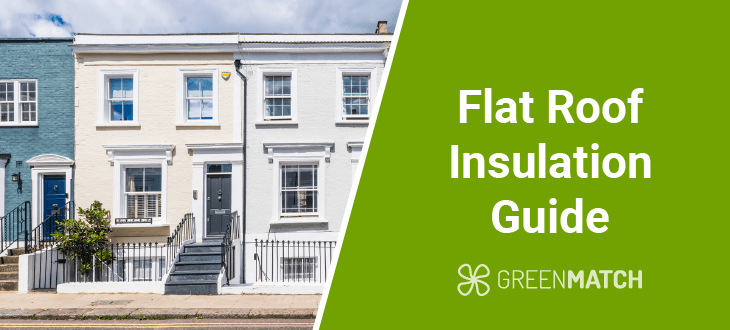
- Flat roof insulation typically costs between £30 and £35 per square metre. Prices may vary based on the chosen material, roof size, and complexity.
- Flat roofs can benefit from both thermal and acoustic insulation. Thermal insulation improves energy efficiency, while acoustic insulation reduces noise pollution by blocking and absorbing sound.
- Five insulation materials suitable for flat roofs include polyisocyanurate boards, expanded polystyrene, extruded polystyrene, mineral wool, and spray foam insulation. These materials are chosen for their effective insulation and moisture protection.
- Polyisocyanurate boards and extruded polystyrene boards are the best flat roof materials for thermal efficiency.
- Flat roof building regulations require roof insulation with a maximum U-value of 0.18 W/m2K. This can be achieved by installing 100mm to 150mm thick insulation.
In the UK, approximately 21 million homes are affected by poor or inadequate insulation, leading to increased energy inefficiency and higher living costs. The roof is a significant area of concern as it can account for up to one-quarter of the heat loss in a home if not properly insulated. This issue is especially critical for homes with flat roofs, as their structure and design present unique challenges for insulation.
Flat roof insulation is essential for maintaining a consistent indoor temperature, reducing energy consumption, and preventing moisture buildup. Effective insulation improves a home's comfort and energy efficiency, reduces heating costs by around £230 annually, and decreases carbon emissions by 0.6 tonnes.
This detailed guide will equip you with the information to insulate your flat roof. We will cover various insulation materials, the best installation practices for warm and cold insulation, flat roof insulation costs, and key information you need to know before upgrading your flat roof. This will help you make informed decisions to improve your home's energy efficiency and comfort.
Ready to upgrade your flat roof insulation? Let GreenMatch UK take care of it! Complete our brief 30-second form to get up to 4 free quotes from reliable, professional installers near you. Say goodbye to the hassle of researching and vetting, and say hello to the best deals. Click below to get started.
- Describe your needs
- Get free quotes
- Choose the best offer
It only takes 30 seconds



What is flat roof insulation?

Insulating a flat roof involves adding a thermal or acoustic barrier to flat or nearly flat roofs to improve energy efficiency, regulate indoor temperatures, prevent moisture-related problems, and potentially reduce noise pollution.
Flat roof insulation can serve both acoustic and thermal purposes. Thermal insulation traps heat within the building during winter, reduces heat loss, and reflects sunlight and heat radiation during summer, keeping the interior cooler. This insulation type significantly lowers energy bills and reduces a home's carbon footprint. Acoustic insulation reduces noise pollution, making it beneficial for homes in densely populated areas.
Flat roof insulation serves multiple purposes, including:
- Deflecting sunlight: Flat roofs are more exposed to direct sunlight throughout the day, causing homes to become hotter in the summer. Insulation foil can help reduce your roof's exposure to heat by deflecting direct sunlight away from your roof.
- Trapping heat: Flat roofs without insulation can become cold during winter, losing one-quarter of your home's heat. Insulation traps heat within the home, keeping your house comfortable during colder months.
- Reduce water pooling: Flat roofs have minimal slopes, so water doesn't run off easily. Insulation is crucial to prevent water pooling and damage. Adding a waterproof barrier with new insulation helps prevent pooling. Tapered insulation creates slopes in the flat roof to address this issue. However, it will slightly change the roof's shape, requiring assessment by local authorities.
- Reducing condensation: Proper insulation helps prevent condensation by maintaining a consistent temperature within the roof structure, reducing the risk of moisture-related issues such as mould and rot.
By insulating a flat roof, you can increase your home's energy efficiency and increase its value by up to 14%. Additionally, you can save an average of £230 annually on energy bill costs. Moreover, acoustic insulation provides a quieter indoor environment, improving the living space's comfort.
Cold flat roof insulation
Cold roof insulation is a method where the insulation material is installed at the ceiling level rather than directly under the roof deck. This means the insulation is placed over and between the ceiling joists, leaving the attic uninsulated and closer to the external temperature. This method is ideal for lofts used only for storage and is practical for loft spaces with limited space.
The cold flat insulation technique is easy and simple to install because it does not require roofers to insulate the roof deck directly. As a result, less material and labour are needed, which reduces the overall cost. The cost-effectiveness and ease of installation are why people choose cold flat roof insulation. Additionally, the ease of installation means that DIY can be possible with this method.
However, installing insulation only at the floor level of your loft may reduce thermal efficiency compared to methods like warm flat roof insulation. Therefore, cold flat roof insulation is best suited for unoccupied attic spaces. This method is unsuitable if you use your loft as a living space.
Additionally, cold roof insulation typically needs ventilation to allow moisture to escape, keeping the roof structure dry and free from damage. This is necessary because airborne moisture makes the unheated attic space prone to condensation.
Cold roof insulation works well for properties where the loft space serves as storage instead of a living area. It provides a cost-effective way to improve the home's thermal efficiency. Proper ventilation is crucial to maintain the longevity and effectiveness of this insulation method.
- Easy to install
- Cost-effective
- DIY possible
- Ideal for storage spaces
- Condensation risk
- Not suitable for loft spaces used as living areas
- Thermal efficiency weaker than other methods
- Ventilation required
Warm flat roof insulation
Warm roof flat insulation involves placing insulation material above the structural deck and below the waterproof membrane. This creates a continuous thermal barrier covering the entire roof structure, which helps keep the building's interior warmer in winter and cooler in summer.
This method is well-suited for attics used as living or storage space. However, warm insulation can reduce headroom within your loft space, so it may not be ideal for lofts with limited headroom.
Using warm flat roof insulation is the best way to insulate your flat roof, as it ensures thermal efficiency in your roof and throughout your home. Insulating the entire roof prevents condensation and eliminates the need for a ventilation system. However, it requires more materials and labour, leading to longer installation times and higher costs. Warm insulation is more complex to install so you will need professional assistance.
Even though it's the most expensive insulation method, it can help prevent moisture damage and reduce the need for a ventilation system in your attic. Its thermal efficiency can extend the lifespan of your flat roof by controlling condensation and protecting it from thermal stress and weather damage. Plus, it can save you more energy bills than cold insulation.
- Improved moisture control
- Lower energy bills
- Higher thermal efficiency
- Suited for living and storage spaces
- High cost
- DIY not recommended
- Complex installation process
- Potential for reduced headroom
Inverted flat roof insulation
Inverted flat roof insulation, also known as the "upside-down warm roof," is a method in which the insulation is placed above the waterproofing layer of the roof structure. After the insulation boards are placed directly on top of the waterproofing layer, they are applied to the roof deck and covered with a ballast layer.
This approach contrasts with traditional "warm roof" and "cold roof" insulation methods, where the insulation is usually installed below the waterproofing layer, thus leaving it vulnerable to damage.
One of the primary advantages of inverted insulation is that it protects the waterproof membrane from potential damage caused by temperature changes. The insulation layer shields the waterproofing membrane from extreme temperature shifts, UV radiation, and physical damage, potentially extending the membrane's lifespan. Additionally, the insulation reduces the risk of condensation by maintaining a stable temperature for the waterproof membrane.
The insulation is covered with a ballast layer made from gravel, pavers, or green roof components. The ballast layer holds the insulation in place and protects it from environmental factors like wind uplift. However, this additional layer adds more weight to the overall structure.
Due to the extra labour and materials involved, installing inverted warm insulation is more costly than warm or cold flat roof insulation. They are complex to install which is difficult for DIY projects. Professional installation will ensure insulation and ballast layers installed correctly.
- Enhanced waterproofing
- Condensation control
- Eco-friendly due to ballast layer
- Durable
- Heavy weight
- Higher costs
- Complex installation
- DIY not recommended
Flat roof insulation regulations
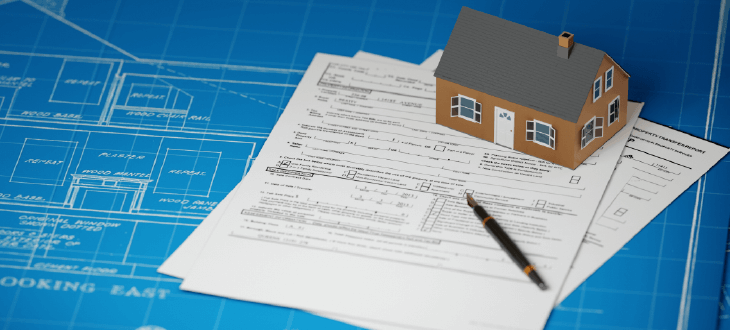
Insulating a flat roof in the UK must comply with specific building regulations to ensure energy efficiency, structural integrity, and safety. While planning permission is generally not required for most flat roof insulation projects, changes that alter the roof's external appearance, such as tapered or inverted insulation, may necessitate contacting the local authority for assessment and potential planning permission.
UK roof insulation building regulations focus on the thermal performance of insulation, specifying that the U-value for flat roofs should not exceed 0.18 W/m2K. The U-value measures the insulation's effectiveness: the lower the U-value, the better the insulation. To achieve these U-values, flat roof insulation thickness typically ranges from 100mm to 150mm, depending on the material used. Anything thinner such as 50mm would not be able to attain the correct U-value.
If the insulation thickness affects the headroom in a living space, the building regulations allow for a lower performance target, but this should be discussed with local authorities. This means that warm insulation thickness can be reduced with the required U-value to maintain appropriate headspace in the living area.
The regulations also stipulate that cold roof insulation should have long-term protection, such as boarded areas above the insulation for maintenance access. Additionally, building regulations highlight that when upgrading or installing new insulation, the materials must be draught-proofed and airtight to maximise thermal efficiency.
These regulations are crucial in ensuring that insulation for a flat roof boosts energy efficiency and promotes environmental sustainability. Contact your local authority for more information. We also advise collaborating with at least one roof insulation expert for expert guidance on building regulations.
At GreenMatch, we can link you with reliable insulation contractors who will assist you through the installation process and building regulations. Complete our 30-second form to receive up to four non-binding quotes from top insulation experts. Click below to find out more.
- Describe your needs
- Get free quotes
- Choose the best offer
It only takes 30 seconds



Insulation materials for flat roof
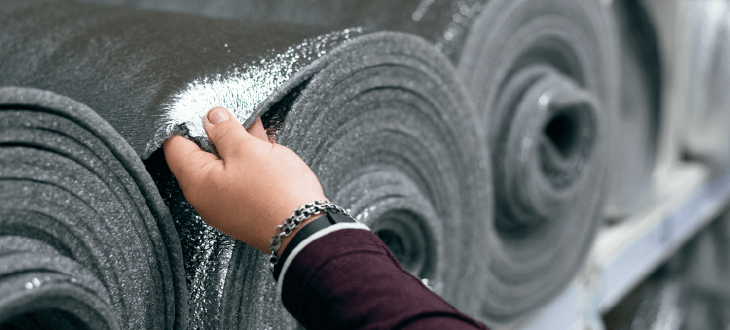
When selecting insulation materials for flat roofs, it is essential to consider specific properties that ensure the material's effectiveness and durability. Flat roofs have unique requirements due to their minimal slope, exposure to direct sunlight, and potential for water pooling. Due to the potential for water pooling, materials such as fibreglass and cellulose are not suitable as they have a tendency to hold onto moisture
Polyisocyanurate (PIR) boards
PIR boards are made of plastic foam and are known for their high thermal resistance (insulation R-value). They provide excellent insulation with an R-value ranging from 5.6 to 7.0. These boards are lightweight, easy to install, compatible with roofing materials, and suitable for insulation of both cold and warm flat roofs.
They are also fire-resistant and have minimal environmental impact during production, producing less waste. Additionally, they are relatively cost-effective, with an average cost of around £12.50 per m2.
Protecting PIR boards from water absorption is essential, as they can absorb up to 3% of their weight in water. This can decrease their effectiveness in providing thermal resistance and lead to mould and rot. Over time, exposure to high temperatures, moisture, and UV rays can reduce their lifespan. However, protected PIR boards can last up to 50 years.
- High R-value
- Lightweight and easy to install
- Cost-effective
- Non-flammable
- Can be used for warm and cold insulation
- Produces less waste during production
- Susceptible to water absorption
- R-value decreases when exposed to water
- Mould and rot can occur when PIR is unprotected
Extruded polystyrene (XPS)
XPS is a thermoplastic foam with high compressive strength and a consistent R-value of 5 to 6, depending on the product and temperature. It is durable, water-resistant, and maintains its thermal properties even in damp conditions, making it ideal for warm and cold roof insulation. It has a lifespan of up to 50 years and is suitable for cold and warm flat roof insulation.
XPS is flammable and will melt and drip, releasing toxic fumes. Due to its flammability, it is also not suitable for some roofing materials and cladding. It is less environmentally friendly due to its fossil fuel origins and non-biodegradability. Additionally, XPS comes at a higher cost than some other insulation materials, on average £21.50 per m2.
- Durable
- Moisture resistant
- High R-value
- Suitable for warm and cold insulation
- High cost
- Flammable
- Not suitable to some cladding and roofing materials
- Not eco-friendly
Expanded polystyrene (EPS)
EPS, or expanded polystyrene, is a lightweight thermoplastic foam with a lower R-value of 4 to 4.5 per inch. It is the most cost-effective insulation material for flat roofs. EPS boards are easy to cut and install, with various thicknesses available. On average, they cost around £10 per m2.
They are also moisture-resistant, which prevents mould and rot growth, making them ideal for flat roofs to help mitigate water pooling. As a result of being moisture resistant, they can last up to 50 years or longer.
However, EPS is less suitable for high-temperature applications and requires additional protective layers to prevent damage. As a result, EPS is not ideal for some cladding and roofing materials. It is also not biodegradable and can release harmful chemicals when burned. Additionally, EPS boards are only suitable for warm, flat roof insulation.
- Cost-effective
- Moisture resistant
- Easy to cut and install
- Various thickness available
- Low R-value
- Flammable
- Not suitable for cold insulation
- Not eco-friendly
Mineral wool
Mineral wool, including rock and glass wool, is manufactured from volcanic rock or recycled glass and sand. On average, mineral wool has an R-value ranging from 3.7 to 4.3 per inch. It provides excellent fire resistance, soundproofing, and moisture resistance. It is suitable for use in warm and cold flat roof insulation systems and lasts up to 50 years.
However, mineral wool is heavier and more challenging to install than other materials. During installation, protective gear is necessary to prevent skin and respiratory irritation.
It is also more expensive than other materials, with glass wool priced at around £15.25 and rock wool at £18.20. While mineral wool can be produced from recycled materials, its production is not environmentally friendly due to heavy machinery, which produces carbon dioxide during manufacturing.
- Fire-resistant
- Water-resistant
- Sound absorption
- Durable
- Suitable for warm and cold insulation
- High cost
- Heavy weight
- Damages skin and lungs without protective gear
- Production emits high levels of carbon dioxide
- Low R-value compared to PIR and XPS boards
Spray foam insulation
Spray foam insulation expands upon application, creating an airtight seal. It is available in open-cell and closed-cell forms. Open-cell spray foam has an R-value of 3.6 to 3.9 per inch, while closed-cell spray foam has an R-value of 6 to 7. Both types are suitable for warm and cold deck insulations. Due to the materials used in creating spray foam, it cannot grow mould or mildew, even if it becomes damp.
Spray foam has a long lifespan and can last up to 100 years if installed properly. The cost of open-cell is £55 per m2, whereas closed-cell is £70 per m2. Additionally, open cell spray foam can expand further than closed-cell foam resulting in a more cost-effective material.
Spray foam is not DIY-friendly and requires professional installation. It can release volatile organic compounds (VOCs) and isocyanates, posing health risks during application. Another drawback of spray foam is that it is flammable, making it prone to spreading fire and releasing toxic chemicals.
- Moisture resistant
- Airtight
- Closed cell spray foam has high R-value
- Long lifespan
- Suitable for warm and cold insulation
- Flammable
- High-cost
- Health risks
- DIY not possible
- Not eco-friendly
What is the best insulation for a flat roof?
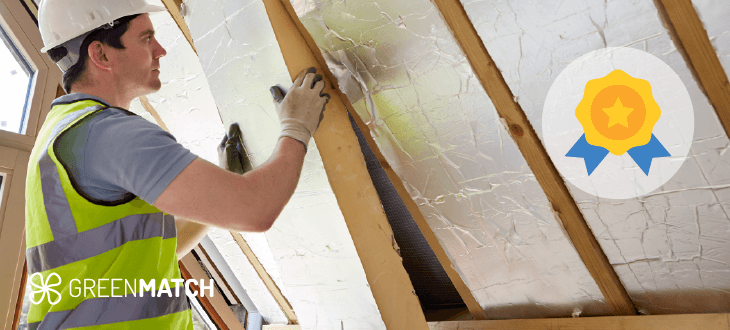
Selecting the best roof insulation material for flat roofs ensures energy efficiency, maintains indoor temperatures, and protects the roof structure. The choice depends on your needs, goals and budget. Below are the best roof insulation materials based on effectiveness:
- Polyisocyanurate (PIR) boards: PIR boards have superior thermal performance with an R-value ranging from 5.6 to 7.0 per inch, providing excellent insulation, lightweight, easy installation, and good fire resistance. However, they can absorb moisture, reducing their effectiveness over time. Proper sealing and waterproofing are essential when using PIR boards.
- Extruded polystyrene (XPS) boards: XPS boards are well-known for their high compressive strength and low moisture absorption. They have an R-value between 5 and 6 per inch, making them durable and effective for flat roof applications where moisture resistance is crucial. XPS suits warm and cold deck insulation and provides excellent thermal resistance. It is less eco-friendly because it derives from fossil fuels and is non-biodegradable.
Above, we have listed the best insulation materials for thermal efficiency to assist with energy savings. However, the best choice for you depends on your specific needs. Each insulation material for a flat roof has advantages and disadvantages, and some may be more suitable for your specific requirements. Consulting with a professional can help you tailor the choice to ensure you choose the best insulation for your flat roof.
How can you choose the right type for your roof
Selecting the suitable insulation material for your flat roof is essential to ensure the roof structure's energy efficiency, indoor comfort, and longevity. Here are some key considerations to guide your decision:
- Moisture requirements: Flat roofs are prone to water pooling, so it is essential to choose a material with effective moisture resistance to prevent mould, mildew, and rot from growing.
- Energy efficiency: Evaluate the R-value of your chosen material. Higher R-values indicate better insulation properties. If your main goal is reducing energy bills, opt for materials with higher R-values.
- Budget considerations: When looking at insulation for a flat roof, consider your budget. If you are looking for more cost-effective insulation, opt for materials such as EPS. However, it is important to note that higher-cost materials such as XPS and spray foam insulation have higher R-values and are more durable, which can reduce energy bills and repair costs.
- Sustainability: Consider eco-friendly options such as PIR boards if sustainability is your top priority.
- Installation requirements: If ease of installation is a priority, consider materials that are easy to cut and fit. Consider EPS boards or spray foam in this case. If you are considering reducing labour costs by DIY-ing your flat roof insulation, note that some materials, such as spray foam, require professional installation.
When choosing the suitable insulation material for your flat roof, it's essential to consider factors such as thermal performance, moisture resistance, environmental impact, budget, and compliance with building regulations.
It's advisable to consult with professionals to ensure that your selection aligns with your specific needs and goals. By carefully considering these factors, you can make an informed decision that enhances your home's energy efficiency, comfort, and overall value.
Flat roof insulation cost
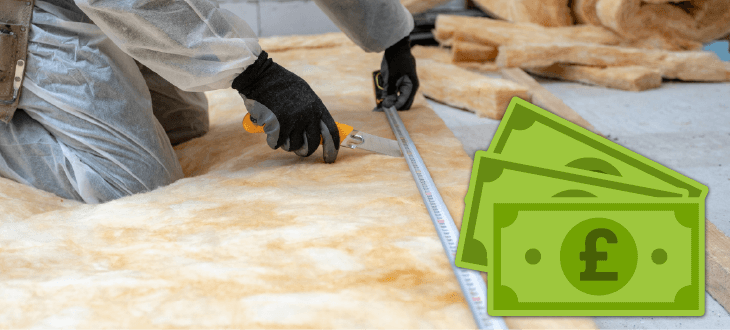
Flat roof insulation costs, on average, between £30 and £35 per square metre. The cost of insulation for a flat roof can vary significantly depending on several factors, such as:
- Roof size: Larger roofs require more insulation material and labour, resulting in higher costs.
- Insulation technique: The insulation method, such as cold, warm or inverted insulation, will affect the cost. Cold roof insulation is much cheaper as it requires less material and labour. In contrast, inverted warm insulation requires more and is more expensive.
- Installation complexity: Roofs with complex features or limited access may require more labour resulting in higher costs.
- Labour costs: Labour rates can vary depending on your location. In cities, for example, labour costs are more expensive as they correspond to higher costs of living.
- Additional features: Adding features such as reflective foil to your insulation will increase the costs but it benefits thermal efficiency for flat roofs
Material costs are another factor to consider when looking at the cost of insulation of a flat roof. Below, we have provided the average costs, including installation, for each flat roof insulation material:
| Material | Average cost per m2 |
|---|---|
| Polystyrene (EPS) board | £10 |
| Polyisocyanurate (PIR) board | £12.50 |
| Polyurethane (XPS) board | £21.50 |
| Mineral wool | £33.45 |
| Spray foam | £62.50 |
How to insulate a flat roof from the inside
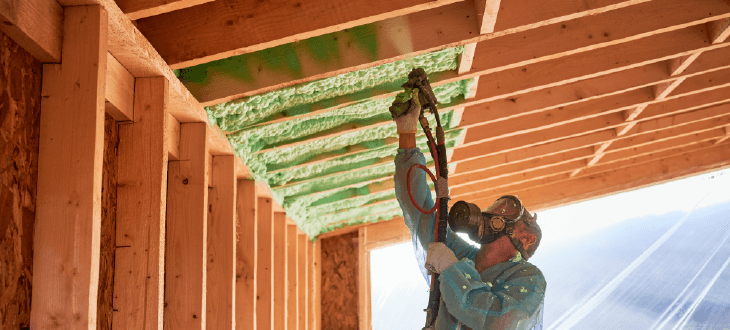
Insulating a flat roof from the inside, also known as internal or cold deck insulation, involves installing insulation between the joists of the roof. This method is particularly useful in home insulation projects where the external structure cannot be altered. Below are the steps for internal flat roof insulation:
- Access the roof space: Inspect the roof for any signs of damage or moisture issues.
- Measure and cut insulation: Wondering how much insulation you’ll need in your roof? Start by measuring the spaces between the joists, then cut the insulation boards to fit snugly in each gap.
- Install vapour barrier: Place a vapour barrier over the joists to prevent moisture from entering the insulation.
- Fit insulation boards: Insert insulation boards between the joists to cover gaps and prevent thermal bridging. Secure boards with adhesives or mechanical fasteners.
- Seal gaps: Use a sealant to fill gaps around the insulation to prevent air leaks.
- Finish with plasterboard: Once the insulation is placed, cover it with plasterboards to access the loft space.
- Inspect and maintain: Inspect insulation regularly for signs of moisture and damage to ensure its longer lifespan and effectiveness.
Insulating a flat roof as a do-it-yourself project is achievable and can be very satisfying, as it offers excellent cost savings and allows for customisation. However, it's essential to consider the potential challenges carefully and to seek professional advice or assistance, especially for roofs that are complex or prone to moisture issues. Working with insulation professionals ensures a high-quality, safe, and compliant installation that maximises energy efficiency and leads to long-term savings.
Are you looking for the best roof insulation installers? Look no further! GreenMatch connects you with top professionals. Fill out our quick 30-second form, and we'll provide you with four free, non-binding quotes customised to your flat roof insulation needs and budget. Click below to discover more.
- Describe your needs
- Get free quotes
- Choose the best offer
It only takes 30 seconds



FAQ
The best way to insulate a flat roof is by using rigid foam boards like PIR or XPS, which offer excellent thermal resistance and durability. Warm roof insulation provides further efficiency and is suitable for all loft spaces. However, the best insulation method should consider personal preferences like budget, sustainability, DIY, and moisture requirements.
Building regulations specify that the total U-value should be no higher than 0.18 W/m2K when insulating a flat roof. This indicates that depending on your chosen insulation material, the thickness of the material should range between 100mm and 150mm to meet the required U-value for roof insulation.
There are five types of insulation that can be used for flat roofs: polyisocyanurate boards, expanded polystyrene, extruded polystyrene, mineral wool, and spray foam insulation. These materials are preferred for their ability to provide effective insulation and protection against moisture.
No, 50mm of insulation is generally not enough for a flat roof to meet UK building regulations. These regulations typically require a U-value of 0.18 W/m2K or lower. Depending on the material used, the insulation thickness usually needs to be between 100mm and 150 mm to achieve this U-value.
The cheapest flat roof insulation is typically expanded polystyrene (EPS), costing around £10 per square metre. EPS is cost-effective but less thermally efficient compared to other materials like PIR and XPS.

Caoimhe is an experienced content writer and researcher who is passionate about providing accessible information to every reader. With a background in English literature and Sociology, she combines the two disciplines to create cohesive, well-thought-out, and well-informed pieces.
We strive to connect our customers with the right product and supplier. Would you like to be part of GreenMatch?

- Flat Roof Insulation: A Complete Guide to Insulating a Flat Roof
- What is flat roof insulation?
- Cold flat roof insulation
- Warm flat roof insulation
- Inverted flat roof insulation
- Flat roof insulation regulations
- Insulation materials for flat roof
- What is the best insulation for a flat roof
- Flat roof insulation cost
- How to insulate a flat roof from the inside
- FAQ
